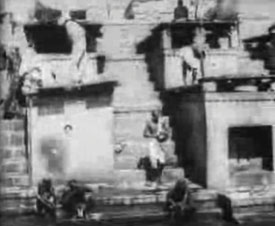 One of the first moving pictures of India was titled Panorama of Calcutta; aka, Local Scenes Calcutta (1899), though it was not actually filmed in Calcutta.
One of the first moving pictures of India was titled Panorama of Calcutta; aka, Local Scenes Calcutta (1899), though it was not actually filmed in Calcutta.
Rather, it shows a busy riverside near the holy city of Varanasi, shot with a stationary camera mounted on a boat drifting along on the Hooghly River.
The British filmmakers travelled with the Warwick Trading Company, making many "actuality" documentaries or travel films.
As the boat clips along, we see a bit less than a minute & a half of people bathing, doing laundry, many large sun embrellas, people in the water, on stairways leading to the water, & so on.
We see carvings of deities in niches, tiny moored boats, children, buildings apparently part of a temple complex, all appealingly exotic & not so different from similar scenes as can be seen along sacred rivers in India even today.
Panorama of Calcutta (1899) was most recently in circulation as an "extra" on a dvd release of Jean Renoir's The River (1951).
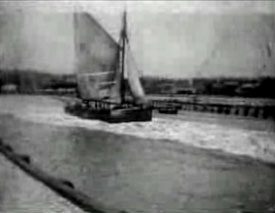 A long lost thirty-second film of the 1890s resurfaced in time to become part of the 1996 centeniary of projected cinema in England.
A long lost thirty-second film of the 1890s resurfaced in time to become part of the 1996 centeniary of projected cinema in England.
It was an actuality film, Yarmouth Fishing Boats Leaving Harbour (1896), first exhibited in a special screening for the royal family.
It may well have been the first royal film program, one day before Princess Maud married Prince Charles, & Acres was invited to attend the wedding with his camera equipment.
The filmmaker, Birt Acres, was inspired by the Edison Manufacturing Company product from America, & made his actualities no different from the least of the Edison product or the Lumiere Brothers.
The little film when rediscovered was in an advanced state of decay so that even the restored version is very rough, which somehow adds to its charm. It shows fishing smacks in Great Yarmouth Harbour, Isle of Wight, rushing along at full sail. It's really two fifteen-second films, but gives the impression of an intentional jump-cut.
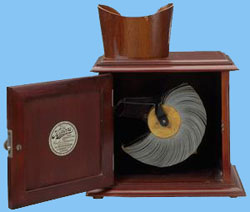 The Kinora flipbook device permitted the viewing of motion pictures inexpensively at home.
The Kinora flipbook device permitted the viewing of motion pictures inexpensively at home.
The viewing device, placed firmly on a table, was a bit larger than a stereoscope permitting one viewer at a time to gaze through the viewer, turning a handle to start a circlular flipbook spinning on its spool.
Films were produced for the Kinora viewer from 1896 to 1914, & it was at the height of its popularity about the turn of the century, fading from public interest after 1910.
A Kinora camera was also sold so that people for the first time could make their own home movies! So both amateur & professional Kinora films exist.
For a while, just about every Victorian household of any means had a Kinora viewer of one type or another, either the type resembling a stereoscope or the type with the machenism inside a wooden abox into which one gazed as into a miniature mutoscope.
Large arcade kinoras also existed but were not as widespread as the small home-use device. Similarly, a tiny home kinetoscope was manufactured to compete with the kinora, but it was such a complex device, it could not compete due to the cost of a kinetoscope, comparative complexity of changing films, plus the kinetoscope needing period "tuning."
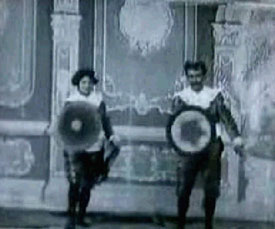 The flipbook films came in small round canisters that look remarkably like modern film canisters. The flipbook films came in small round canisters that look remarkably like modern film canisters.
Director or photographer credits are rarely known unless the flip-cards were taken from Lumier celluloid films, but a contemporary Kinora advertisement showed a woman making the flipcard films with a special Kinora camera.
An unusually entertaining example of a kinora film is Coldino Juggling with Carpets (circa 1900). It features two jugglers, a man & a woman dressed rather like Renaissance courtiers.
They twirl & toss circular throw-rugs in an exceedingly beautiful manner, standing against an ornate backdrop to increase the aesthetic appeal.
They multiply the round rugs from two to three as the act progresses. The woman drops one but picks it up & continues without missing more than a single beat, twirling the rug like pizza dough.
I could find no information about a juggler named Coldino, but assume this flipbook film preserved a carnival or vaudeville act of the day, & the Coldinos could've been from anywhere in Europe. If Coldino was not merely a stage-name, then they must've been from Denmark.
copyright © by Paghat the Ratgirl
|
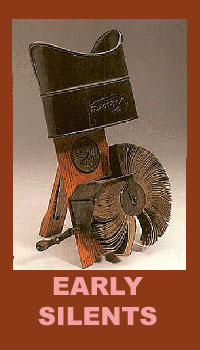



 The flipbook films came in small round canisters that look remarkably like modern film canisters.
The flipbook films came in small round canisters that look remarkably like modern film canisters.